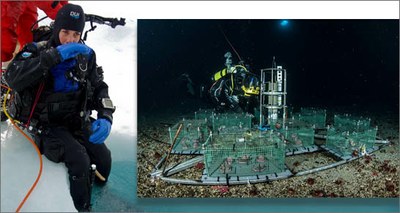Climate: Antarctica, first data from the Ross Sea underwater laboratory
16/9/2021
 A special underwater laboratory, set up by ENEA at a depth of over 25 meters in the Ross Sea in Antarctica, made it possible to acquire data on temperature, pH, oxygen, salinity and pressure that allowed to accurately describe the annual variation of physical, chemical and biological processes under the pack ice in Terra Nova Bay, which confirmed that one of the major causes of climate change is ice melting. The data were collected continuously and in high resolution for one year until November 2019 and then published in studies in the international journal "Minerals"
A special underwater laboratory, set up by ENEA at a depth of over 25 meters in the Ross Sea in Antarctica, made it possible to acquire data on temperature, pH, oxygen, salinity and pressure that allowed to accurately describe the annual variation of physical, chemical and biological processes under the pack ice in Terra Nova Bay, which confirmed that one of the major causes of climate change is ice melting. The data were collected continuously and in high resolution for one year until November 2019 and then published in studies in the international journal "Minerals"
The activity, part of the ENEA coordinated project Ice ClimaLizers during the 34th and 35th Italian expeditions to Antarctica – was funded by the National Program for Research in Antarctica (PNRA) to study the variation of the chemical and physical characteristics of seawater, using calcifying marine organisms like bryozoans and coralline algae as environmental indicators and potential 'sentinels of climate change'.
"Through plankton consumption and by building carbonate skeletons, these organisms store carbon and play a strategic but still little known role to assess what is happening, especially to polar regions where changes are occuring very rapidly and the harsh environment makes it hard to collect data, due to the high risk of damage or loss of instruments”, pointed out Chiara Lombardi, researcher at the ENEA Biodiversity and Ecosystem Services Laboratory in the Santa Teresa Research Center.
Terra Nova Bay is a crucial site, because that’s where the so-called Dense Shelf Water is formed, that is the uppermost ocean water mass, in contact with local coastal ecosystems, which transfers 'information' to the Antarctic Bottom Water, which in turn affects the circulation and nourishment of the entire ocean. A recent study published in "Nature Geoscience" confirms that the increase in concentration of human-generated carbon dioxide recorded in the last 40 years in the Antarctic Bottom Water was affected by the interannual variability associated with local variations in the chemical-physical properties of water (temperature, salinity, etc.).
“The ongoing climate change, the complexity of the processes and the variability recorded even on very small scales shown by the study, make it necessary to increase field observation sites to acquire additional data, especially in the polar regions. Recording the rapid changes taking place, both in surface and deep polar waters, is crucial to monitor their effects on marine biodiversity: the oceans, in fact, absorb approximately 93% of the earth's heat and 25% of the carbon dioxide (CO2) released in the atmosphere and are the planet’s largest ecosystem. A healthy ocean means a healthy planet ” Lombardi pointed out.
The project Ice ClimaLizers was conducted jointly with the CNR Institutes of Marine Sciences of Bologna and Marine Engineering of Genoa, the Oceanographic Institute of Sopot (Poland), the University of Portsmouth, the Natural History Museum of London (United Kingdom) and the CNRS (France).
For more information please contact:
Chiara Lombardi, ENEA – Laboratory of Biodiversity and Ecosystem Services - Santa Teresa Research Center chiara.lombardi@enea.it
Free images to reproduce:
Link to the publication “Minerals, special issue: Polar marine carbonates”: https://www.mdpi.com/2075-163X/11/4/374
